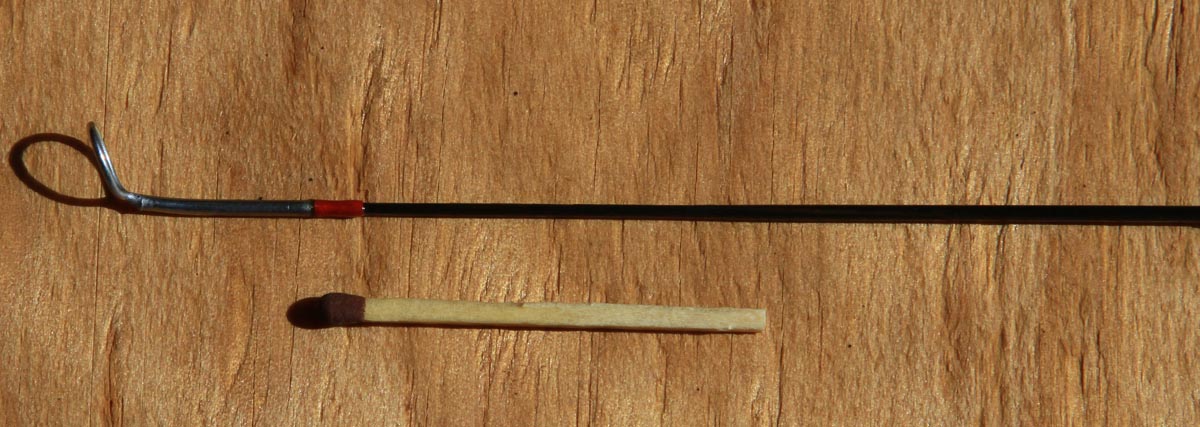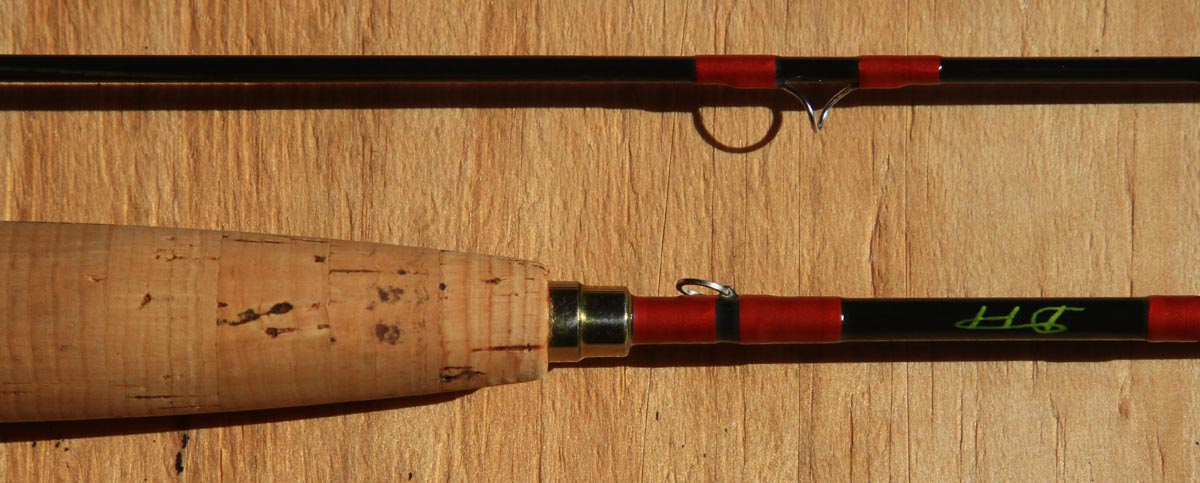The solid boron fly rods of Don Phillips – Part 1
Ed Herbst
‘Whatever its nature, Lilliput water in any form offers the fly fisher one constant thing. This is its store of bright, and somehow cheerful little trout, as wild as the midget creatures on which they prey. Sadly, few of us pay lasting tribute to the Lilliputs we know, forgetting our debts to such waters for our earliest tuition, or shrugging the miniscule away as now beneath our notice.’ Peter Turnbull-Kemp, ‘Lilliput Water’, Piscator no 91, 1974.
I started fly angling in 1979 soon after moving to Cape Town and very quickly realised that the only facet of the sport I was interested in was fishing small streams – Lilliput water - with the most delicate rods available and small flies.
The late Peter Turnbull-Kemp, whose quote heads this article, used a Leonard Baby Catskill 36 L coupled with an Orvis CFO 2 reel and though I have never been able to acquire a Baby Catskill (six foot and weighing one ounce for a 2 wt) I did acquire a rod which was just as delicate and even more exotic and I fished it with a CFO2.
At that time my guiding light was the American magazine FlyFisherman and through it I was introduced fly fishers like Ernest Schweibert, Lefty Kreh, Dave Whitlock and others who cut through the fog, levelled the learning curve and taught me in hours what they had taken years if not decades to learn.
It was through the magazine that I became aware of the solid boron rods of Don Phillips and quickly acquired four rods ranging from a six foot 2 wt to a one-off nine foot 2/3 wt.

Ed Herbst with a rainbow trout caught on the Holsloot stream near Cape Town on Don Phillips’ boron version of the Leonard Baby Catskill. Photo by Jeanne Welsh
The shortest rod was Phillips’ attempt to replicate the Baby Catskill and I will take the liberty of providing you with an extract from Ernest Schweibert’s brilliant and definitive two-volume work, Trout (E.P.Dutton, New York, 1978) as a background to this, the first of two articles on the remarkable rods of Don Phillips.

The tips of Don Phillips rods are extremely fine as they are formed over a boron fibre mandrel.
While their tips were as thin as the lead in a propelling pencil, Phillips claimed that the solid construction of his rods made them far more robust than tubular carbon fibre rods. To prove the point he would hit his rods with a hammer! (http://www.performanceflyrods.com/catalog/dp-boron.jpg)
The Story of Borontochloride
By Ernest Schweibert
‘The day was cold and raw.
It was a strange time to test an exotic new fishing rod. The hotel doorman was busy hailing taxis from the traffic that filled Fifty-ninth Street, and a brittle winter sun tried to warm the bare trees in Central Park
The Theodore Gordon Flyfishers were having their annual March banquet in Manhattan. The membership was gathering before lunch to explore the tackle manufacturers' booths and to attend the films and lectures scheduled in the ballroom of the Essex House.
Later I was sitting in the bar with Charles De Feo and Everett
Garrison, enjoying a mixture of whisky and winter twilight among the
leather and mahogany millwork and mirrors. It was early in 1973.
Can you spend fifteen minutes? It was Don Phillips, an aeronautical engineer from Hartford. Phillips held a slim six-foot tube in his hands. I've got something here that might surprise you.
Fly rod? I asked.
Heard you express some doubts about building really delicate rods with aerospace fibres, Phillips explained. So I built you a surprise.
Graphite, I asked, or something else?
Boron, Phillips said quietly.
We walked to the main ballroom, which stood empty after the last fishing program. We moved along the centre aisle below glittering chandeliers, and through acres of folding chairs that had witnessed years of weddings, bar mitzvahs, and cotillions.
Phillips drew a frail-looking rod from its six-foot case. Its calibrations were startling, the butt was scarcely the diameter of a soda straw, and its tip section was as delicate as a pencil lead. Such diameters were a revelation after years of fishing the fat fibreglass tapers that evolved just after the Second World War.
Even the first tubular carbon-fiber prototypes, which I had field- tested before Fenwick introduced them, seemed fat in comparison.
It's pretty delicate, I said.
It's an exaggeration to make my point, Phillips admitted. But I decided to copy the Leonard one-piece Baby Catskill in boron-because you thought it was impossible.
Can l try casting it?
That's why I brought you in here, he said.
Phillips produced a Hardy Flyweight fitted with a two-weight British silk. It seemed strange in the empty ballroom, casting a half-ounce rod and its antique line, and watching it deliver casts on the faded carpets.
Well, I said sheepishly after a dozen casts, I've been wrong before.
Don Phillips was the first to understand the potential of boron filaments in fly rod design.
The Phillips rods are not tubular designs, but solid boron fabricated over a wire mandrel, which makes them much thinner than other manufacturers’ rods, but also heavier due to their density.
Phillips built his first boron prototypes late in 1971, and took his first trout with one that following spring on the Battenkill. His first rods were adaptations of the early Howald patents in fibreglass construction and their boron tapes were shaped around a balsawood armature. Phillips was excited about his first experiments, but admits they were relatively fragile.
Other concepts were tried later and he finally settled on a solid boron design formed around a 03-inch diameter tungsten core held in tension.
It is a hundred percent boron construction, with its permanent tungsten armature. Its solid construction on a tungsten core made both sleeve- and spigot ferrule designs unworkable. Phillips decided on all German-silver ferrules, like those still used on expensive cane rods and his boron rods are still fitted with them today.

Fitted like an expensive cane rod
It was a series of happy accidents, Phillips explains. We were working on propeller and rotor applications of carbon fibres at Hamilton Standard in 1966 – and stress analysis in propellers and helicopter rotors is surprisingly close to describing the oscillations of working stress in fishing rods.
Phillips has filled more than 350 orders since 1972, and owns the pioneering patents on solid-boron fabrication and several boron- hybrid composite designs.’
Don graduated in 1955 from the University of Massachusetts with a Mechanical Engineering degree and in 1970 he received his Masters Degree in Business Management from the Rensselaer Polytechnic Institute's Hartford Graduate Centre. He made about 700 rods in all and went on to write the definitive book, The Technology of Fly Rods (Frank Amato Publications, Portland, 2000).
(http://www.fishandfly.co.uk/bookrevs/rods.html
http://globalflyfisher.com/reviews/books/phillips/).
Now retired, he lives in Naples, Florida and has written books about salt water fly fishing and the marine ecosystem in that area. Visit his website at: http://www.cyberisle.com/tropical/angler.htm.
I have put three Don Phillips rods on sale. All three were made towards the end of Phillip’s manufacturing run.
(http://www.tomsutcliffe.co.za/pete-briggs/177-auction-of-ed-herbst-rods-and-reels)
The 9 foot rod has been the most deadly rod on the strike when fishing small nymphs that I have ever used. For whatever reason, its length, its limber delicate tip or the fact that its action suited my slow reflexes, I never seemed to miss a strike or drop a fish when using it with small PTNs and soft hackles.

The six foot six inch 3-4 weight Don Phillips rod (number 614) which is now on sale. This rod features Phillips’ unusual cork-and-wood reel seat and grip.
One of these rods, the 6’ 6” 3-4 –weight (number 614), will be on display at Craig Thom’s Stream-X fly fishing shop in Milnerton, Cape Town and will be sold through him. (www.streamx.co.za)
The second article in this series will be one Don wrote at my request and which was carried in the July 1982 issue of Piscator, journal of the Cape Piscatorial Society. (http://www.piscator.co.za/)


